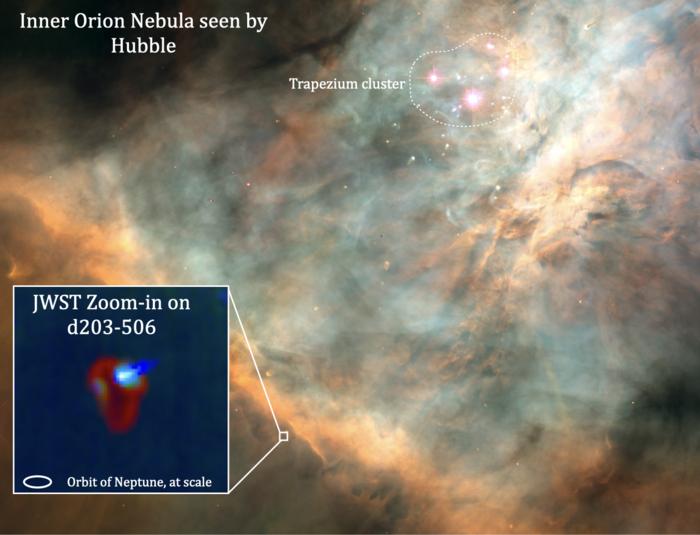How do planetary systems such as the Solar System form? To find out, CNRS scientists taking part in an international research team1 studied a stellar nursery, the Orion Nebula, using the James Webb Space Telescope2. By observing a protoplanetary disc named d203-506, they have discovered the key role played by massive stars in the formation of such nascent planetary systems3.

Credit: © NASA/STScI/Rice Univ./C.O’Dell et al / O. Berné, I. Schrotter, PDRs4All
How do planetary systems such as the Solar System form? To find out, CNRS scientists taking part in an international research team1 studied a stellar nursery, the Orion Nebula, using the James Webb Space Telescope2. By observing a protoplanetary disc named d203-506, they have discovered the key role played by massive stars in the formation of such nascent planetary systems3.
These stars, which are around 10 times more massive, and more importantly 100,000 times more luminous than the Sun, expose any planets forming in such systems nearby to very intense ultraviolet radiation. Depending on the mass of the star at the centre of the planetary system, this radiation can either help planets to form, or alternatively prevent them from doing so by dispersing their matter. In the Orion Nebula, the scientists found that, due to the intense irradiation from massive stars, a Jupiter-like planet would not be able to form in the planetary system d203-506.
This paper, which will make the front page of the journal Science on 1st March, 2024, shows with unprecedented precision the decisive role played by massive stars in shaping planetary systems, and opens up new perspectives on how such systems form.
Notes :
1 – The main French laboratories involved in this study are: the Institut de Recherche en Astrophysique et Planétologie (CNES/CNRS/Université Toulouse Paul Sabatier), Institut d’Astrophysique Spatiale (CNRS/Université Paris-Saclay), Laboratoire d’Etudes du Rayonnement et de la Matière en Astrophysique et Atmosphères (CNRS/Université Cergy Paris/Observatoire de Paris-PSL/Sorbonne Université/), and Institut des Sciences Moléculaires d’Orsay (CNRS/Université Paris Saclay). The study is part of the international ‘ PDRs4All ‘ project.
2 – The James Webb Infrared Space Telescope can peer through dust clouds, thus revealing with unparallelled clarity distant celestial bodies such as the Orion Nebula, 1400 light-years from Earth.
3 – Systems that are less than a million years old.
Journal
Science
DOI
10.1126/science.adh2861
Article Title
A far-ultraviolet-driven photoevaporation flow observed in a protoplanetary disk
Article Publication Date
1-Mar-2024




